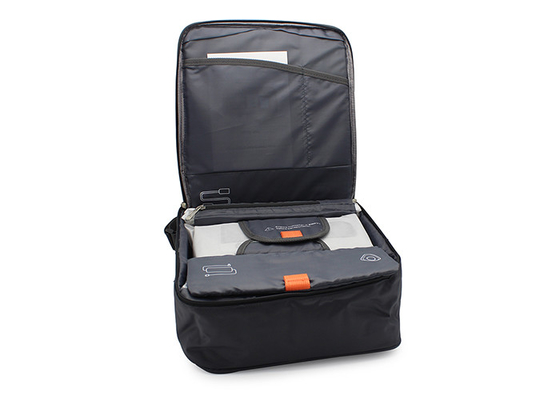|
|
Non Invasive Positive Pressure Bipolar Ventilation Ventilator For Asthma Patients , Stylish Design
|
Product Details:
Payment & Shipping Terms:
|
| Screen: | 128*64 LCD | Colour: | Gray |
|---|---|---|---|
| Pressure: | 4-20cmH2O | EPR (1-3 Level): | 2-4cmH2O |
| Working DB: | ﹤30dBA (working At 10cmH2O) | Net Weight: | 3.9kg |
| Size: | 38*36*16 CM | Ramp Duration: | 0-60mins |
| Function: | Treat Pulmonary Heart Disease | Product Name: | Health Medical Ventilator Sleep Apnea |
| Data Storage: | SD Card | DC Voltage: | 24VDC |
| DC Current: | 2.0A Maximum | ||
| High Light: | automatic cpap machine,cap machine sleep apnea |
||
Non Invasive Positive Pressure Bipolar Ventilation Ventilator For Asthma Patients , Stylish Design
Product Feature
| 1 |
Auto-adjusting pressure for personalized treatment during sleep |
| 2 |
Auto-Altitude compensation:the pressure can be adjusted according to altitude to |
| 3 | Alarm for power off and mask off |
| 4 | Humidifier can heat without tank |
| 5 |
overheating protection: humidifier will auto-off when overheating |
| 6 | Real-Time display treatment data |
| 7 | 0-3 level EPR (expiratory pressure relief) |
| 8 | Alarm for power off or disconnected |
| 9 | 16GB SD card can save about 5years used records |
| 10 | Parameters lock: all the parameters cannot be changed after setting |
| 11 | Combined smart technologies |
| 12 | Contemporary and stylish design for bedroom appeal |
Product Description
The bipap machine is a small, ventilator suitable for non-invasive positive pressure ventilation. It is easy to use, flexible, and reliable. With the continuous improvement of medical standards, especially after the prevention and treatment of SARS, the bipap ventilator began to enter the primary hospital on a large scale. The clinical application of the bipap ventilator is reviewed as follows to improve the use of the bipap ventilator, to treat patients with dyspnea, and to assist the patient to breathe better.
working principle
The working principle of the bipolar ventilator lies in the pressure difference of the gas. When the ventilator is ventilated, the mechanical drive makes the airway pressure higher than the alveolar pressure, and the gas enters the lungs. After the external mechanical drive is removed, the thoracic and lung elastic retraction. The alveolar pressure is greater than the airway pressure and the gas is removed from the lungs. From this we can see that in the process of human breathing, the ventilator can only perform lung ventilation function, that is, it plays a part in the external respiration and has little effect on internal respiration, that is, the gas exchange effect on the pulmonary capillaries and alveoli is relatively Smaller.
Product Picture
![]()
Product Specification
| Product Name | Medical Cpap Machine |
| Screen | 128*64 LCD |
| Colour | Cray |
| EPR (1-3 level) | 4-20cmH2O |
| Working dB | ﹤30dBA (working at 10cmH2O) |
| Ramp Duration | 0-60mins |
| Net Weight | 1.8kg |
| Size | 255*170*112mm |
| Function | Treat Adult Obstructive Sleep Apnea |
| Accessories | The standard accessaries include a set of Nasal Mask, Head Belt, 6ft. Tubing, Filter, Power Cord, User's Manual and Carrying Case. |
Precautions During Use Of Home Ventilators
1.Intolerance:
When using the ventilator for the first time, the patient may feel uncomfortable. The nursing staff should give guidance, adjust the mask, adjust the parameters, and give psychological care. After the synchronization between the human and the machine, the patient's discomfort will be reduced or disappeared.
2.Oropharyngeal drying:
When using a ventilator, the patient may have dry mouth oropharynx. The mask should be adjusted to reduce air leakage and drink plenty of water. The use of a humidifying humidifier can effectively eliminate the above discomfort.
3.Facial crush:
In the stressed parts, such as: nose, , use a Q-shaped skin protective film.
Flatulence, discomfort:
Try to use the nose to breathe, talk less, and use drugs that promote gastric motility if necessary, such as: morphine.
4.Mouth leaks:
If a nasal mask is used, the mouth should be closed as much as possible when using the ventilator. Air leaks in the mouth can reduce the effect. If necessary, use a nose and mouth mask or use a chin strap to adjust the tightness of the mask in time.
5.Drainage obstacles:
When the patient has a sputum dysfunction, the family should regularly turn the patient over to pat the back, encourage more drinking water, guide the patient to have a cough and sputum sputum, and if necessary, inhale, if necessary, the family can give sputum
-
Portable Good Night Auto Cpap Machine Sleep Apnea Treatment With Humidifier
-
Home Use CPAP Breathing Machine With Automatic Altitude Adjustable Function
-
2.8 Inch Screen Non Invasive Auto Cpap Machine / Cpap Device For Treat Sleep Apnea
-
Traveling Bipap Auto Cpap Accessories Portable Medical Ventilator OLV - DS6
-
Health Medical Ventilator Automatic Cpap Machine Battery Operated Sleep Apnea Using
-
Automatic Altitude Compensation Mini Home Breathing Machine For Relieve Breathing Difficulties








